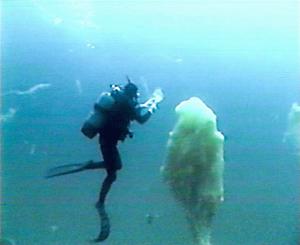National Geographic, though, reports that blobs like these - called "mucilages" - are on
 the rise:
the rise:As sea temperatures have risen in recent decades, enormous sheets of a mucus-like material have begun forming more often, oozing into new regions, and lasting longer, a new Mediterranean Sea study says (sea "mucus" blob pictures).
And the blobs may be more than just unpleasant.
Up to 124 miles (200 kilometers) long, the mucilages appear naturally, usually near Mediterranean coasts in summer. The season's warm weather makes seawater more stable, which facilitates the bonding of the organic matter that makes up the blobs (Mediterranean map).
Now, due to warmer temperatures, the mucilages are forming in winter too--and lasting for months.
[...] Mucilages aren't a concern for just the Mediterranean, Danovaro added. Recent studies tentatively suggest that mucus may be spreading throughout oceans from the North Sea (map) to Australia, perhaps because of rising temperatures, he said.
It would certainly be unnerving to run into one of these. While they won't devour you like the horror-film Blob, the article - which you can read here - notes that they "are hot spots for viruses and bacteria, including the deadly E. coli."

Leave a comment: